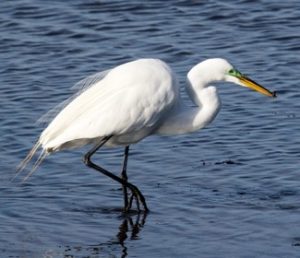Gag Grouper
Mycteroperca microlepis

Image by Robert Aguilar, Smithsonian Environmental Research Center on Flickr, CC BY 2.0
Physical: The gag grouper is a brown-grey fish with dark blotchy markings on the body and dark lines around the eyes. They have dark fins with white edges on the anal (bottom) fin and tail. One characteristic feature is the serrated spur on the bottom of the cheek. Gag grouper are known as protogynous hermaphrodites. This means that they are all born female, and can change to male over time if no other males are present. Adults can grow up to 36 in (91.4 cm).
Habitat: Their range includes North Carolina, the Yucatan Peninsula, and eastern Brazil. While juveniles have been spotted as far north as Massachusetts, they primarily live further south. Therefore, most gag grouper found in the Barnegat Bay are southern strays who made their way north. Juveniles live in estuaries and seagrass beds. Adults live offshore on rocky bottom or places with solid structures like reefs.
Feeding: Gag grouper are predators who feed on fishes (including other gag grouper), crabs, shrimps, and cephalopods (squid). Juveniles feed mainly on small crustaceans (crab, shrimp) in shallow grass beds.
Breeding: Spawning takes place from December to May, over the continental shelf. Females spawn multiple times per season, laying anywhere between 60,000 to 1.7 million eggs each time.

Sign up for email or connect through social media.